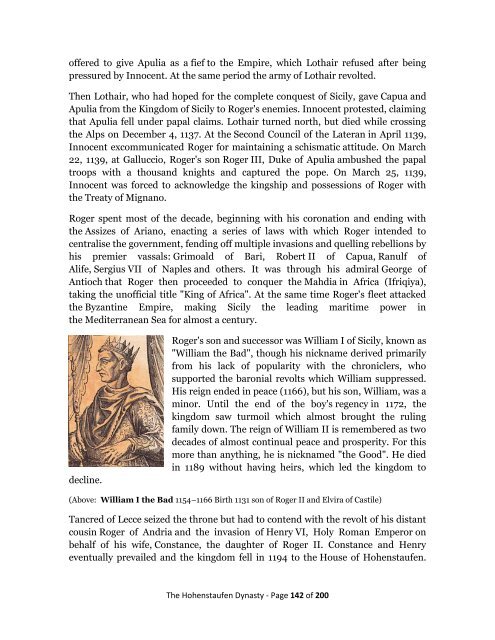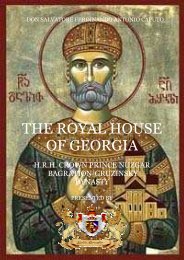here - Nobility Associations
here - Nobility Associations
here - Nobility Associations
You also want an ePaper? Increase the reach of your titles
YUMPU automatically turns print PDFs into web optimized ePapers that Google loves.
offered to give Apulia as a fief to the Empire, which Lothair refused after being<br />
pressured by Innocent. At the same period the army of Lothair revolted.<br />
Then Lothair, who had hoped for the complete conquest of Sicily, gave Capua and<br />
Apulia from the Kingdom of Sicily to Roger's enemies. Innocent protested, claiming<br />
that Apulia fell under papal claims. Lothair turned north, but died while crossing<br />
the Alps on December 4, 1137. At the Second Council of the Lateran in April 1139,<br />
Innocent excommunicated Roger for maintaining a schismatic attitude. On March<br />
22, 1139, at Galluccio, Roger's son Roger III, Duke of Apulia ambushed the papal<br />
troops with a thousand knights and captured the pope. On March 25, 1139,<br />
Innocent was forced to acknowledge the kingship and possessions of Roger with<br />
the Treaty of Mignano.<br />
Roger spent most of the decade, beginning with his coronation and ending with<br />
the Assizes of Ariano, enacting a series of laws with which Roger intended to<br />
centralise the government, fending off multiple invasions and quelling rebellions by<br />
his premier vassals: Grimoald of Bari, Robert II of Capua, Ranulf of<br />
Alife, Sergius VII of Naples and others. It was through his admiral George of<br />
Antioch that Roger then proceeded to conquer the Mahdia in Africa (Ifriqiya),<br />
taking the unofficial title "King of Africa". At the same time Roger's fleet attacked<br />
the Byzantine Empire, making Sicily the leading maritime power in<br />
the Mediterranean Sea for almost a century.<br />
decline.<br />
Roger's son and successor was William I of Sicily, known as<br />
"William the Bad", though his nickname derived primarily<br />
from his lack of popularity with the chroniclers, who<br />
supported the baronial revolts which William suppressed.<br />
His reign ended in peace (1166), but his son, William, was a<br />
minor. Until the end of the boy's regency in 1172, the<br />
kingdom saw turmoil which almost brought the ruling<br />
family down. The reign of William II is remembered as two<br />
decades of almost continual peace and prosperity. For this<br />
more than anything, he is nicknamed "the Good". He died<br />
in 1189 without having heirs, which led the kingdom to<br />
(Above: William I the Bad 1154–1166 Birth 1131 son of Roger II and Elvira of Castile)<br />
Tancred of Lecce seized the throne but had to contend with the revolt of his distant<br />
cousin Roger of Andria and the invasion of Henry VI, Holy Roman Emperor on<br />
behalf of his wife, Constance, the daughter of Roger II. Constance and Henry<br />
eventually prevailed and the kingdom fell in 1194 to the House of Hohenstaufen.<br />
The Hohenstaufen Dynasty - Page 142 of 200



